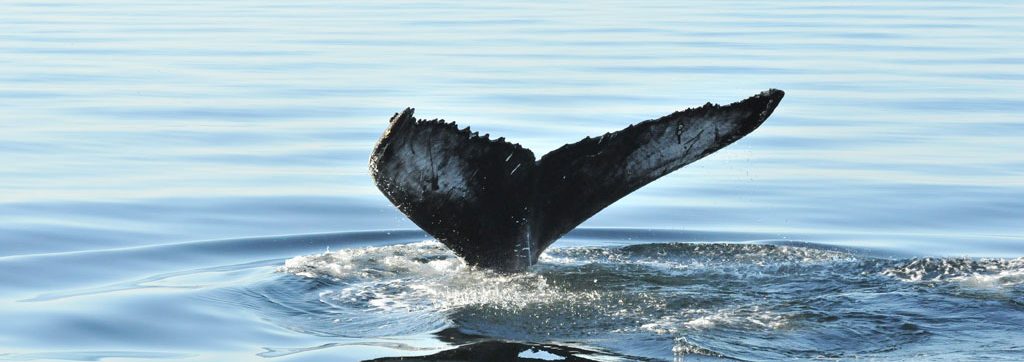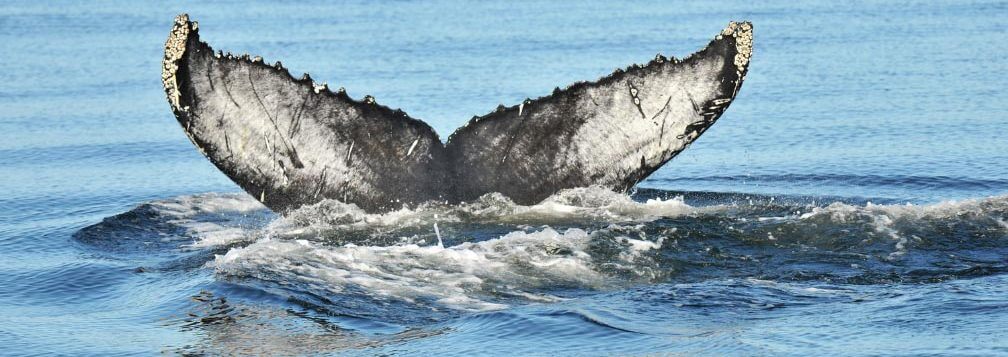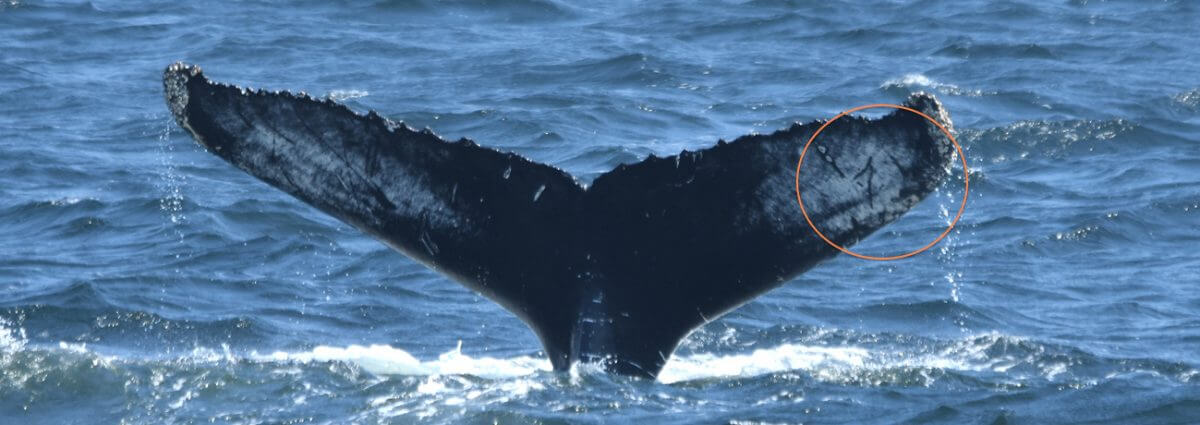Aramis
Humpback Whale


-
ID number
H689
-
Sex
Female
-
Year of birth
2007
-
Known Since
2007
Distinctive traits
We recognize this individual thanks to her undertail colour pattern, which has earned her her name taken from the Three Musketeers. On her right lobe, there are two lines that intersect like two swords.
Life history
Born in early 2007 in the warm waters of the Caribbean, Aramis is the first calf of Tic Tac Toe, an individual regularly seen in the Gaspé Peninsula, the Mingan Islands and the Saguenay-St. Lawrence Marine Park. At the time, they caused quite a stir when they arrived together in the estuary. While humpback whales are frequently seen with their young in the Gulf, this was an unprecedented event in this sector of the St. Lawrence. Like his mother, Aramis has adopted the region. In fact, they are still sometimes seen swimming together.
On July 16, 2013, a team from GREMM and Fisheries and Oceans Canada attached a telemetric tag to her back. In addition to enabling the team to assess the animal’s dive depth and speed, this measure gave Parks Canada the opportunity to collect data on its diet.
Observations history in the Estuary
Years in which the animal was not observed Years in which the animal was observed
Latest news from the publications Portait de baleines
At last, a familiar humpback has arrived in the Marine Park! We recognize this individual thanks to her undertail colour pattern, which has earned her her name taken from the Three Musketeers. On her right lobe, there are two lines that intersect like two swords. Aramis has been observed in the Estuary since 2007, the year she was born. She is thus 9 years old. Sometimes she is observed alone, sometimes accompanied by her mother, Tic Tac Toe. In 2007, this duo represented the first observation of a humpback mother-calf pair swimming together in the history of the Marine Park. Perhaps one day we will have the chance to see Aramis accompanied by a young of her own…
Aramis was admired from multiple angles during her time in the Marine Park. Some observers saw her floating on the surface, exposing the tip of her large dorsal fin. This resting behaviour is known as “logging”. Others also observed her accompanied by a young humpback, the calf of Fleuret, swimming by her side in near synchronized fashion. Associations between rorquals are poorly documented. In toothed whales, they have been studied in sperm whales, belugas and killer whales, where individuals of the same species form long-term partnerships that last for years. In contrast, in baleen whales such as rorquals, associations seem to be more temporary and short-lived. Why group together? To reduce the risk of predation? To increase one’s chances of finding food? A hunting strategy? Group formation and the number of individuals composing the group vary not only based on the species, but also on the environment being used. In the St. Lawrence, rarely are large groups of humpbacks observed feeding, as is sometimes observed in other feeding grounds.
The name of Aramis was inspired by the colour pattern under her tail. The two lines on her right lobe resemble two swords that cross like those of musketeers. Aramis was first seen in the Estuary in 2007, the year she was born. She was accompanied by her mother Tic Tac Toe, an individual often observed in the Gaspé, the Mingan Islands and in the Saguenay–St. Lawrence Marine Park. Aramis was Tic Tac Toe’s first calf. The two of them are sometimes still observed swimming together. Since then, Aramis has been seen every year in the Marine Park. This season she was seen several times in the company of Gaspar, another humpback. As humpbacks reach sexual maturity at about 5 years, 8-year-old Aramis would therefore be old enough to reproduce. One day we might be lucky enough to see her in the area with a calf of her own.
Humpback whales leave the cold, rich waters waters in the autumn and migrate to the warmer Caribbean for breeding and calving. These warm waters offer more favourable conditions for those activities. For some individuals, migration is not critical. For example, in any given year, some juvenile males are not competitive enough to reproduce and some females do not give birth or mate. It is therefore more advantageous for these individuals to stay where food is more plentiful, rather than travelling thousands of kilometres to warm but nutrient-poor waters. As testified by some observers, it is not unheard of to observe humpbacks or other whales during the cold winter months.
Elle y est arrivée en début de semaine, après un passage remarqué en Minganie, où elle a été photographiée par le MICS. Jeune femelle de six ans, elle a probablement atteint sa maturité sexuelle : est-ce que ce sera bientôt son tour d’être accompagnée d’un petit?
Le 16 juillet dernier, une équipe conjointe GREMM–Pêches et Océans Canada posait une balise télémétrique sur le dos d’Aramis. Déployée à l’aide d’une longue perche, fixée à l’aide d’une ventouse, la balise émet un signal radio chaque fois qu’Aramis fait surface et enregistre toutes les secondes la profondeur et la vitesse de la baleine. En parallèle, Parcs Canada étudie la présence des proies là où la baleine se trouve. De quoi répondre à bien des questions sur l’alimentation des baleines!




